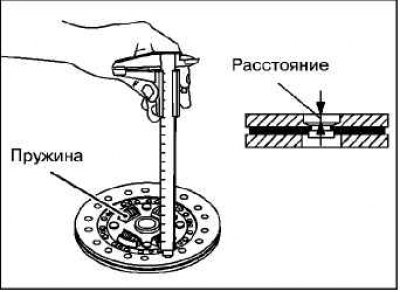Clutch cover
Inspect the ends of the diaphragm spring petals for wear and uneven heights of the ends of the petals. Replace parts if wear is obvious, or if the height difference between the ends of the petals exceeds the limit value.
Limit value: 0.5mm
Check the pressure plate surface for cracks and discoloration.
Check the security of the rivets. If there is a gap, replace the clutch cover.
Driven clutch disc
Attention! Do not clean the clutch disc in a cleaning solvent.
Check running surfaces for loose rivets, uneven contact, sticking, or oils and greases. If defects are found, replace the clutch disc.
Note. If traces of grease or oil are found, determine the source of contamination and eliminate it.

Measure the distance between the head of the rivet and the working surface of the lining. Replace the clutch disc if the distance is less than the limit.
Minimum limit: 0.3mm
Check the condition of the damper springs. If there are defects, replace the clutch disc.
Mount the clutch disc on the drive shaft and check that the disc moves freely on the splines and free play in the direction of rotation. If the disc sticks on the splines, clean, reassemble and recheck.
If excessive play is evident, replace clutch disc and/or drive shaft.
Clutch Release Bearing
Attention! The clutch release bearing is filled with grease. Therefore, do not wash it in a cleaning solvent.
Check for jamming, damage, noise, or binding/tight rotation.
Check for wear on the surface that comes into contact with the diaphragm spring.
Check for wear on the surface that comes into contact with the clutch release fork. If abnormal wear occurs, replace.
Clutch release fork
If the surface that comes into contact with the bearing has excessive wear, replace the yoke.
